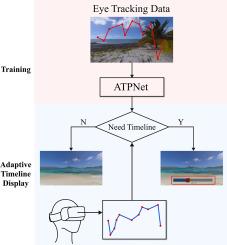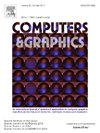在 VR 环境中探索自适应 360° 视频时间轴
IF 2.5
4区 计算机科学
Q2 COMPUTER SCIENCE, SOFTWARE ENGINEERING
引用次数: 0
摘要
时间轴控制是视频观看过程中的重要交互方式,可帮助用户快速定位或跳转到视频播放中的特定点,尤其是在处理冗长的内容时。360° 视频能够提供全方位的视角,与单一视角的视频相比,它能提供更身临其境的体验,因此逐渐受到人们的欢迎。虽然目前大多数 360° 视频都是在二维屏幕上显示的,但时间线的设计与传统视频基本保持相似。然而,虚拟现实(VR)头显为 360° 视频提供了更身临其境的观看体验,并为时间轴设计提供了更多的维度。在本文中,我们通过改变时间轴的形状和交互距离,初步探索了 6 种时间轴设计风格,旨在发现更适合 360° 视频的 VR 环境的设计。随后,我们引入了一种基于眼睛注视序列的自适应时间轴显示机制,以优化时间轴,解决时间轴持续可见时阻碍视线和分散注意力等问题。通过两项研究,我们首先证明了在 360° 空间中,三维时间轴的可用性优于二维时间轴,可触及时间轴的性能和体验优于远距离时间轴。其次,我们验证了在不影响交互效率和系统可用性的情况下,自适应显示时间轴因其对用户时间轴需求的准确预测而获得了更多用户的青睐。本文章由计算机程序翻译,如有差异,请以英文原文为准。

Adaptive 360° video timeline exploration in VR environment
Timeline control is a crucial interaction during video viewing, aiding users in quickly locating or jumping to specific points in the video playback, especially when dealing with lengthy content. 360°videos, with their ability to offer an all-encompassing view, have gradually gained popularity, providing a more immersive experience compared to videos with a single perspective. While most 360°videos are currently displayed on two-dimensional screens, the timeline design has largely remained similar to that of conventional videos. However, virtual reality (VR) headsets provide a more immersive viewing experience for 360°videos and offer additional dimensions for timeline design. In this paper, we initially explored 6 timeline design styles by varying the shape and interaction distance of the timeline, aiming to discover designs more suitable for the VR environment of 360°videos. Subsequently, we introduced an adaptive timeline display mechanism based on eye gaze sequences to optimize the timeline, addressing issues like obstructing the view and causing distractions when the timeline is consistently visible. Through two studies, we first demonstrated that in the 360°space, the three-dimensional timeline performs better in terms of usability than the two-dimensional one, and the reachable timeline has advantages in performance and experience over the distant one. Secondly, we verified that, without compromising interaction efficiency and system usability, the adaptive display timeline gained more user preference due to its accurate prediction of user timeline needs.
求助全文
通过发布文献求助,成功后即可免费获取论文全文。
去求助
来源期刊

Computers & Graphics-Uk
工程技术-计算机:软件工程
CiteScore
5.30
自引率
12.00%
发文量
173
审稿时长
38 days
期刊介绍:
Computers & Graphics is dedicated to disseminate information on research and applications of computer graphics (CG) techniques. The journal encourages articles on:
1. Research and applications of interactive computer graphics. We are particularly interested in novel interaction techniques and applications of CG to problem domains.
2. State-of-the-art papers on late-breaking, cutting-edge research on CG.
3. Information on innovative uses of graphics principles and technologies.
4. Tutorial papers on both teaching CG principles and innovative uses of CG in education.
 求助内容:
求助内容: 应助结果提醒方式:
应助结果提醒方式:


